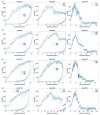Application of Poly(lactic Acid) Composites in the Automotive Sector: A Critical Review
- PMID: 39518267
- PMCID: PMC11548468
- DOI: 10.3390/polym16213059
Application of Poly(lactic Acid) Composites in the Automotive Sector: A Critical Review
Abstract
The introduction of bio-based matrices in automotive applications would, in principle, increase their sustainability and, in case the use of secondary raw materials is also involved, even result in reduced resource depletion. The bio-based polymer composite matrix that has been mainly brought forward towards industrial application is poly(lactic acid) (PLA), which has often been proposed as the replacement for matrices based on polyolefins in fields such as packaging and short-term commodities since, in general, it matches the needs for conventional thermoplastic production processes. The passage to the automotive sector is not obvious, though: problems affecting durability, the relation with water and the environment, together with the requirement for outstanding mechanical and impact performance appear very stringent. On the other hand, PLA has obtained durable success in additive manufacturing as a competitor for acrylonitrile butadiene styrene (ABS). Also, the perspective for 3D and 4D printing does not appear to be confined to bare prototyping. These contrasting pieces of evidence indicate the necessity to provide more insight into the possible development of PLA use in the automotive industry, also considering the pressure for the combined use of more sustainable reinforcement types in automotive composites, such as natural fibers.
Keywords: additive manufacturing (AM); bio-based polymers; mechanical characteristics; natural fibers; vehicle components.
Conflict of interest statement
The authors declare no conflict of interest.
Figures






References
-
- Rahman M.Z., Rahman M., Mahbub T., Ashiquzzaman M., Sagadevan S., Hoque M.E. Advanced biopolymers for automobile and aviation engineering applications. J. Polym. Res. 2023;30:106. doi: 10.1007/s10965-023-03440-z. - DOI
-
- Cywar R.M., Rorrer N.A., Hoyt C.B., Beckham G.T., Chen E.Y.X. Bio-based polymers with performance-advantaged properties. Nat. Rev. Mater. 2022;7:83–103. doi: 10.1038/s41578-021-00363-3. - DOI
-
- Hossain M.T., Shahid M.A., Akter S., Ferdous J., Afroz K., Refat K.R.I., Jamal O.F.M.S.I., Uddin M.N., Samad M.A.B. Cellulose and starch-based bioplastics: A review of advances and challenges for sustainability. Polym.-Plast. Technol. Mater. 2024;63:1329–1349. doi: 10.1080/25740881.2024.2329980. - DOI
Publication types
LinkOut - more resources
Full Text Sources

